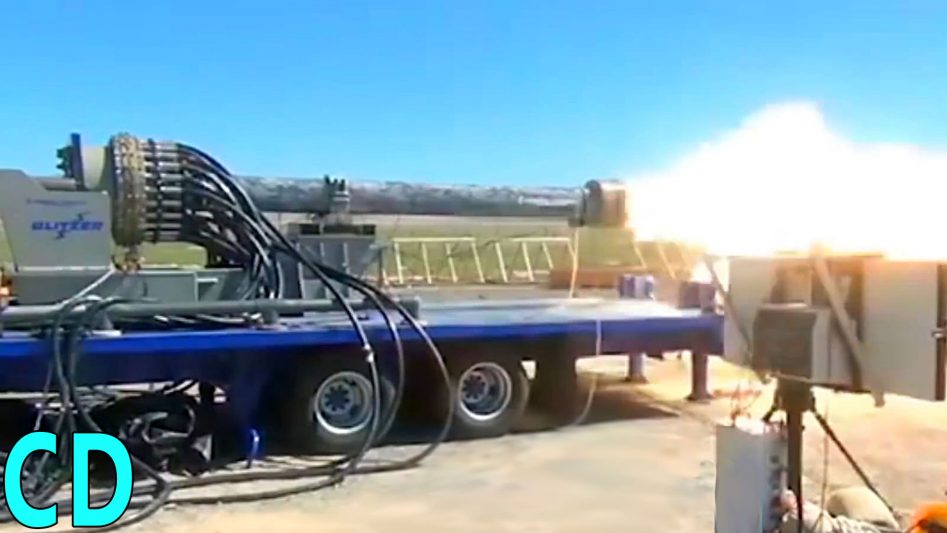‘Velocitas Eradico’– sounds like the sort of thing Harry Potter would say when fighting Voldemort, which would be quite apt as the translation of ‘Velocitas Eradico’ is “quickly get rid” or in the vernacular ‘Speed Kills’ and is the motto for the no less futuristic US Navy Electromagnetic Railgun project.
Before we set the comments on fire about the Latin, it seems that ‘Velocitas Eradicat’ would be a better translation of ‘Speed Kills’, I’ll leave it to you Latin scholars out there the let me know in the comments.
Now, back to the railgun, some might be saying why do we need a new gun, we have precision guided missiles that can travel 1000’s of Kilometres and the massive 16” and 18” guns used on the World War 2 class battle ships have been made almost obsolete by the aforementioned missiles and the rest can be taken care of by aircraft.
In World War 2, the weaponry was cheap and easy to make. 10’s of thousands of planes, tanks and millions of bombs and shells were produced. The US won the war because they could out manufacture the Germans and the Japanese whilst keeping their manufacturing base safe.
Modern warfare is now about keeping the action at arm’s length whilst keeping troops off the ground where possible. Carpet bombing and massive artillery bombardments of large areas doesn’t always produce victories as was seen in Vietnam. Today, precision weapons reduce collateral damage but remote control drones, high tech planes and guided missiles are not only extremely expensive to buy but also to develop in the first place. The US has a stockpile of around 3500 cruise missiles at about $800,000 each and these can’t be mass produced like the old style shells, the same applies to things like new planes but at much higher costs.
As a way to provide a lower cost, fire support with less reliance in airpower or expensive missiles, the US Navy was looking at a way to firing hundreds or thousands of low cost guided ordinance reaching upto 200 miles or 320km from the beach on to thousands of targets a day.
Conventional large navel guns are limited by the rate of gas expansion from the explosive used to propel the projectile, giving them a range of about 45km but with mussel velocities of a round 800m/second. A kinetic tank round has a mussel velocity of up to 1900m per second but have a range of only a few kilometres.
The goal of the railgun is to deliver a guided projectile, which is currently kinetic but could explosive in the future at around 2500km per second upto 200 miles or 320km although with current technology the range is about 120km.
The current generation of electromagnetic railguns can accelerate a 10kg projectile from zero to more than Mach 6 in just 10 milliseconds. Emerging from the barrel in a plume of fire, these are as close as you can get to man-made meteorites, raining down on enemy targets far beyond the horizon.
Railguns might appear to be futuristic weapons but the idea first appeared almost a hundred years ago, when French inventor Louis Octave Fauchon-Villeplee submitted a patent for an ‘Electrical Apparatus for Propelling Projectiles’ in 1919. By 1944, the Nazis drew up more advanced plans, for an anti-aircraft railgun that would use as much power a large city, this was, however, never built but caused a great deal of interest when the plans were discovered after the war.
The railgun works because of the ‘Lorentz force’, discovered by engineers and mathematicians in the 19th century, and named after the Dutch Nobel-prize winning physicist Hendrik Lorentz.
The physics behind a railgun is simple enough to be demonstrated in a home built railgun Two parallel electrically-conductive ‘rails’ are connected to a large power source. One rail has a positive charge, and the other, a negative charge: to fire the gun, a moving armature or bridge connects the two, completing the circuit. This armature can either be a metal projectile, or a thin foil on the back of a non-metallic shell, that carries current across a plasma arc. When the electrical energy travels through the circuit, a very strong electromagnetic field is created and pushes the projectile down the barrel, and out towards the target.
In the video the squarish looking object loaded in to the gun is the ‘sabot’ with the moving armature and the projectile is placed inside it. When the ‘sabot’ exits the barrel, it breaks apart leaving the projectile which has been accelerated to around 2,500 meters per second.
The amount of electrical power discharged during a firing is around 5 million amps at 1200 volts for about 5 milliseconds which works out at around 30 mega joules of power.
In theory, this force is scaleable and would allow for on-demand, almost limitless acceleration. But in early railgun prototypes, the forces were so great that is caused the rails to move apart, creating intense plasma arcing and friction that destroyed the rails and barrel, making repairs necessary after every shot.
Engineers have continued to work on the technology and Electromagnetic weaponry and propulsion are looking more and more attractive. For the same reason, laser weapons have also seen significant investment in recent decades, famously as a way to shoot down incoming ICBMs.
A high-powered railgun could do the same job, and so in 2005, the American Office for Naval Research (ONR) contracted BAE Systems to produce a prototype. The ‘Electo-Magnetic Laboratory Rail Gun’ is the result: it uses a 25-megawatt power-plant – enough to power almost 19,000 homes – to create pulses of capacitor-based power.
Phase two of BAE’s contract began in 2012, working towards a railgun with repeat fire capability. To achieve this, BAE’s barrel design use’s advanced materials to resist ablation, and fire 5 shells per minute. The range of the weapon will be 125 miles about 200km, firing at speeds of up to 5,600mph (9000 kph), with high accuracy. Firing at this rate, the total power of the weapon will be 32 megajoules of muzzle energy per minute. To achieve the 200 mile 320km range, the energy required will be around 64 Megajoules but as yet there aren’t the high power capacitors or the materials available to survive the multiple firings per minute but will undoubtedly be developed as time goes by. Currently only the Zumwalt class destroyers of the US Navy with their 78Mw of power have enough capacity to power the 32Mj railguns but other ships are looking to be upgraded.
General atomics have also produced a version called the blitzer which it looking to make both land and ship based.
Land bombardments aren’t the only use the Navy is looking at. Because the speed of the projectile is so high it could intercept an incoming supersonic anti-ship cruise missile at a distance much further away than relying traditional antimissile systems or phalanx guns. This ability could also be used against planes or even ballistic missiles. By having a proximity exploding projectile, it doesn’t have to score a direct hit, it explodes just before interception for create a cloud of hypersonic shrapnel to hit a much larger target area.
Another advantage is that the railgun’s projectiles are compact: a ship could hold enough to carry out more shore bombardments than an aircraft carrier full of planes. With compact ammunition, the practical scale of a railgun weapon becomes more viable, and on extended operations, gives a huge advantage in firepower. Another advantage of kinetic weapons without warheads is that if the ship were to be hit there is much less chance of a catastrophic ammo explosion like those which destroyed ships in the past like the HMS Hood and HMS Barham.
In the future railguns might be miniaturised further, and find their way onto tanks and aircraft. But as a ground-based platform, there are non-military uses that could accelerate the development of useful working railguns. At NASA’s Applied Physics Laboratory at Kennedy Space Centre, studies are investigating using electromagnetic propulsion to accelerate a wedge-shaped spacecraft to Mach 10, on a trajectory high in the atmosphere.
Then the spacecraft’s on-board propulsion would engage to circularise, delivering a payload into orbit for a fraction of the cost of a traditional launch. NASA has a significant body of existing technology to draw on, such as the X-43A or X-51: scramjet-powered vehicles that have been shown to work in the real world.
Whether for peaceful or destructive applications, the investment in rail gun technology is likely to make its way from science fiction to practical use in the next decade or two. Without a doubt, these machines will put on a spectacular show as they accelerate into an electrified future.
So thanks for watching and I just like to say that this episodes shirt was the Trip Paisley surf by Madcap England and is available from Atomretro.com with worldwide shipping for here in the UK.




Comments
Railgun is useless as you can’t guide the rounds. EMP fields from the gun is so high it destroys all semiconductor electronics even behind several inches of shielding. Besides arriving with Mach 7 speed is also near useless as you must convert the kinetic energy into potential energy. As the A-10 proved at much lower mach numbers, digging a lot of holes in the ground makes a great show of throwing dirt around, but in the end, the bad guy just has to wear a helmet to keep the falling dirt from knocking him unconscious. WWII proved this as well as what did all the damage to buildings etc was setting them on fire. Industrial machinery is made out of heavy steel generally and even HE does almost nothing to them. Now, setting things on fire on the other hand, warps steel/machinery, destroys electrical circuits and the building itself. HE just blows holes in the building and then you have to hope they do not repair the roof in time and the rain can rust things to oblivion.